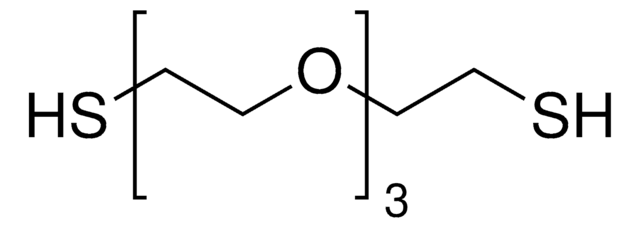717142
Poly(ethylene glycol) dithiol
average Mn 1,000, thiol
Synonym(s):
Polyethylene glycol, PEG dithiol
Sign Into View Organizational & Contract Pricing
All Photos(2)
About This Item
Linear Formula:
HSCH2CH2(OCH2CH2)nSH
UNSPSC Code:
12162002
NACRES:
NA.23
Recommended Products
Product Name
Poly(ethylene glycol) dithiol, average Mn 1,000
form
solid
Quality Level
mol wt
average Mn 1,000
reaction suitability
reagent type: cross-linking reagent
reactivity: thiol reactive
mp
29-33 °C
Ω-end
thiol
α-end
thiol
polymer architecture
shape: linear
functionality: homobifunctional
storage temp.
2-8°C
Looking for similar products? Visit Product Comparison Guide
Application
Thiol functionalized nanoparticles may be used in mucoadhesive drug delivery, synthesis of dithiol terminated amphiphilic diblock copolymer, Bidentate dithiol-poly(ethylene glycol)-poly(d,l-lactide) (SH2-PEG-PDLLA). Gold nanoparticles may be easily functionalized with PEG dithiols by simple ligand exchange.
Other Notes
Molecular weight: Mn 900-1,100
Signal Word
Warning
Hazard Statements
Precautionary Statements
Hazard Classifications
Eye Irrit. 2 - Skin Irrit. 2 - STOT SE 3
Target Organs
Respiratory system
Storage Class Code
11 - Combustible Solids
WGK
WGK 3
Flash Point(F)
Not applicable
Flash Point(C)
Not applicable
Choose from one of the most recent versions:
Already Own This Product?
Find documentation for the products that you have recently purchased in the Document Library.
Customers Also Viewed
Dithiol-PEG-PDLLA micelles: preparation and evaluation as potential topical ocular delivery vehicle.
Jian Yang et al.
Biomacromolecules, 15(4), 1346-1354 (2014-03-13)
Thiol-modified nanoparticles have potential applications in mucoadhesive drug delivery and have been examined in this regard for topical ocular delivery. In this paper we provide a simple method for the synthesis of a dithiol terminated amphiphilic diblock copolymer. Bidentate dithiol-poly(ethylene
Nadeau J
Introduction to Experimental Biophysics: Biological Methods for Physical Scientists null
Qiang Wei et al.
ACS biomaterials science & engineering, 6(8), 4687-4701 (2021-01-19)
Hydrogels have been widely explored for the delivery of cells in a variety of regenerative medicine applications due to their ability to mimic both the biochemical and physical cues of cell microniches. For bone regeneration, in particular, stiff hydrogels mimicking
Our team of scientists has experience in all areas of research including Life Science, Material Science, Chemical Synthesis, Chromatography, Analytical and many others.
Contact Technical Service














